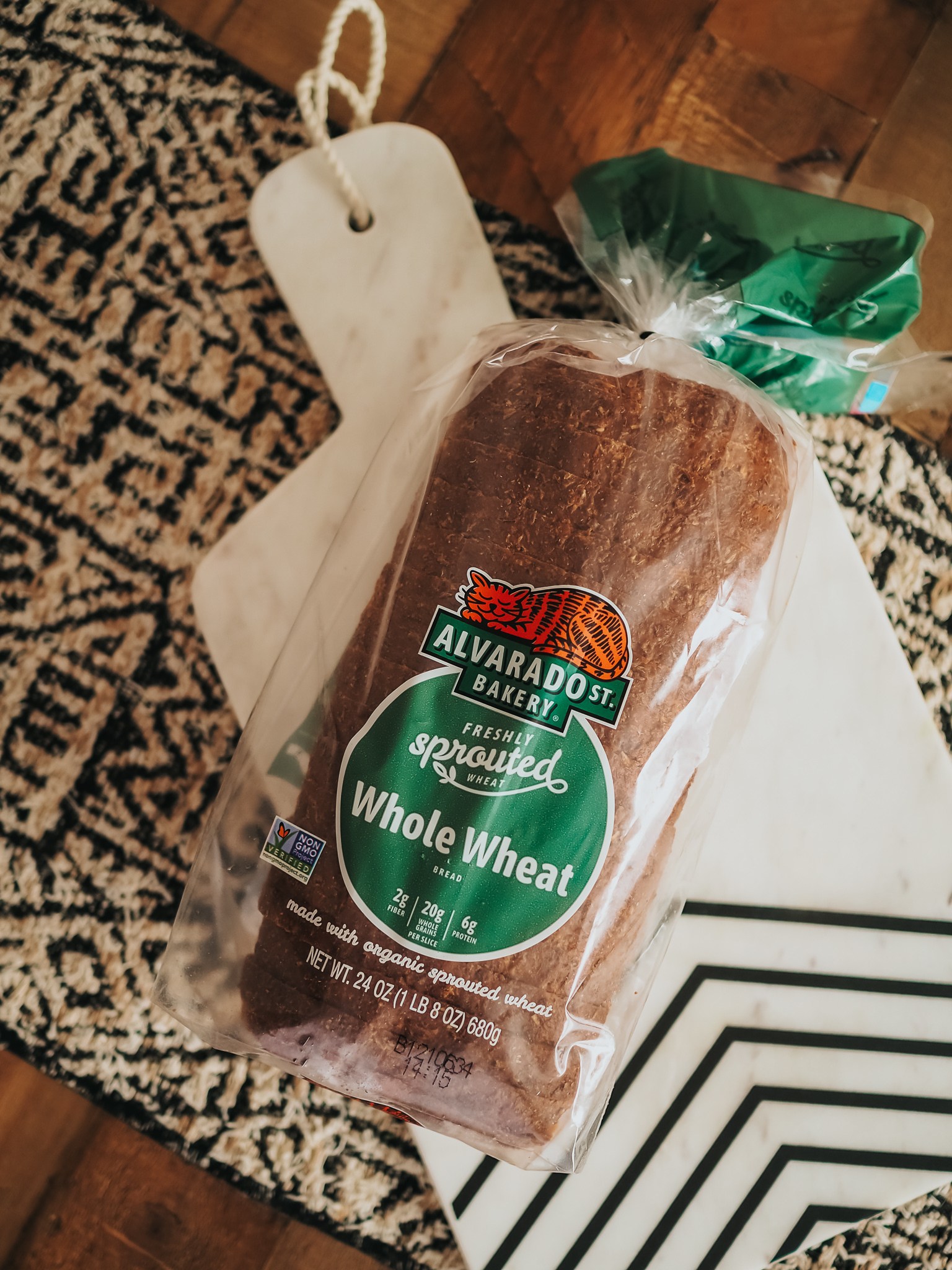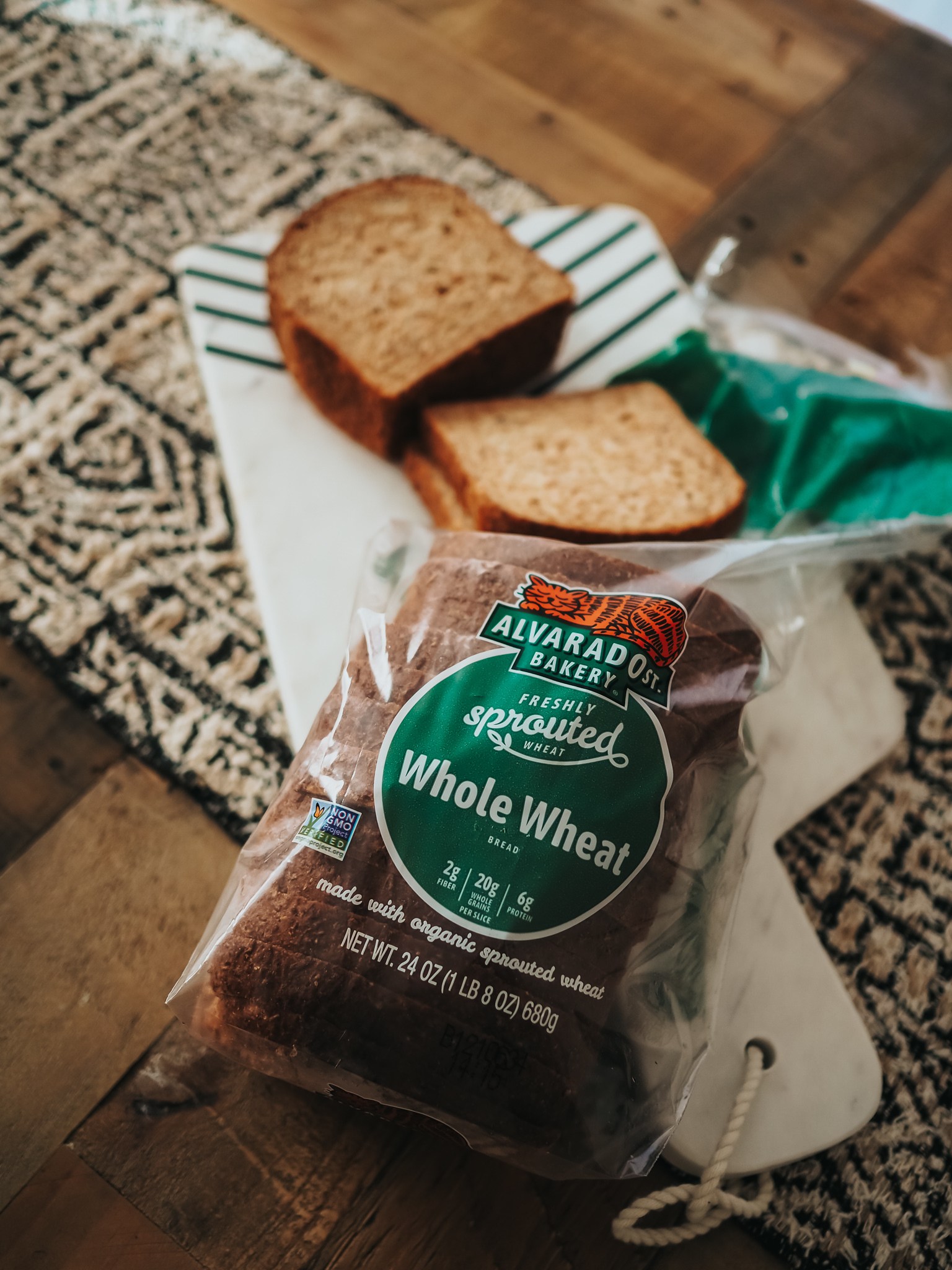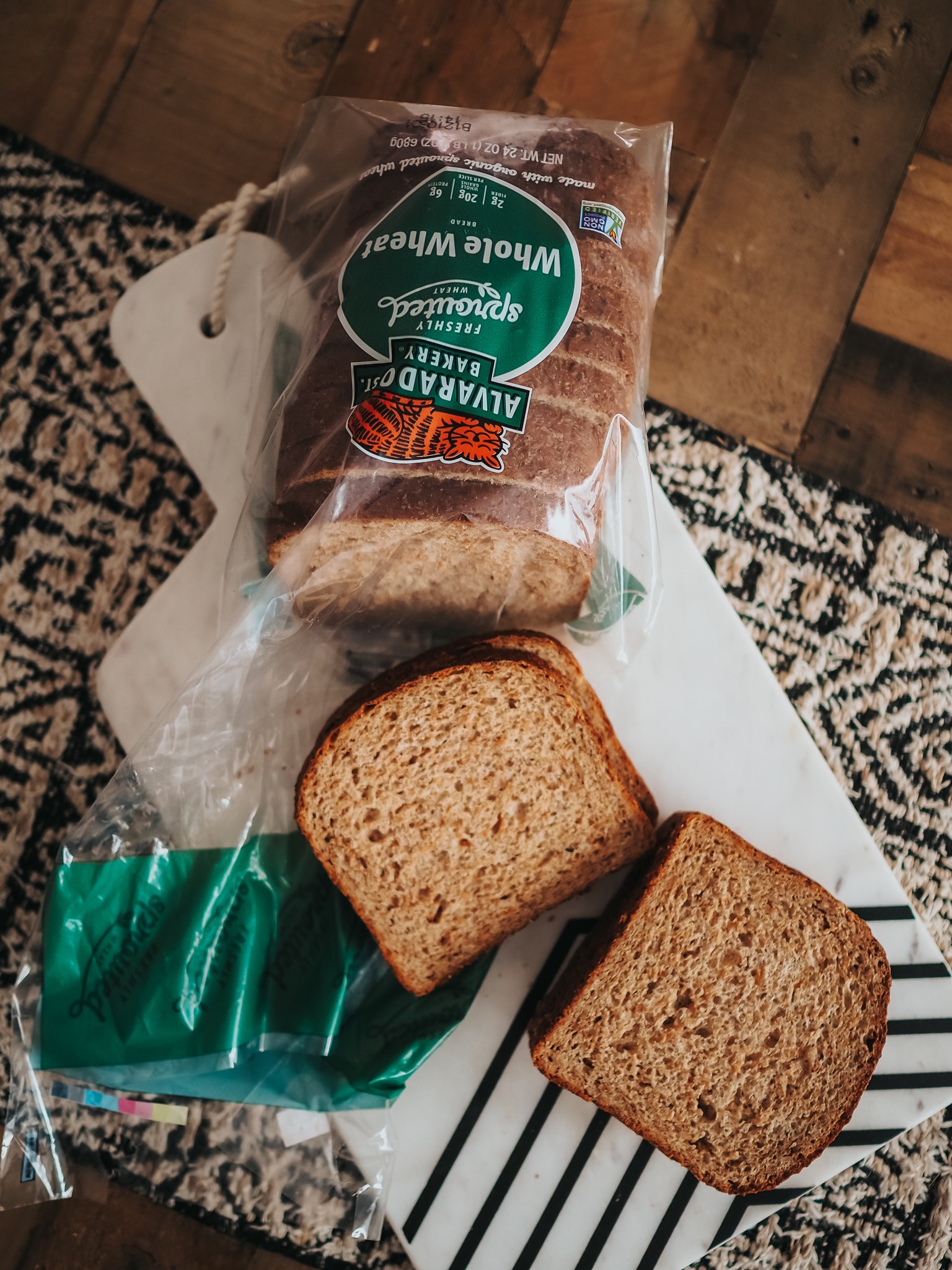Vegan bread has become increasingly popular as of late. Sort of like “clean” beauty and soap brows. It’s having an Instagram moment. As an on again, off again dairy free pescatarian myself – and an avid carb lover – I’m a big fan of vegan bread. I make it, I buy it, I eat a lot of it.
But bread is a complex topic (it can also be a complex carb). People often have a lot of strong opinions about bread and I’d argue that most people view carbs as a thing to cut out – rarely a thing to include in a healthy diet. Let’s challenge that mindset today.
If you’re on the hunt for the ins and outs of what to look for when shopping for healthy vegan bread, the best vegan bread brands, and the best vegan bread recipes to try at home – this blog post is for you.


A little about ME: why I’m even qualified to write this blog post.
Well hello there. My name is Kelsey and I’ve been blogging here at Blondes & Bagels since 2015. I’m a content creator, a social media manager for major international brands, and (the most relevant to this blog post) I’m a certified holistic health coach.
I received my health coaching certificate from the Institute of Integrative Nutrition. You can read my full blog post detailing my experience at IIN here. I am not currently taking on clients, but rather am using my many hours of training and education to produce content for YOU! My readers. At IIN the curriculum covers over 100 different dietary theories and strongly believes in bioindividuality – that every body is unique and may need or flourish on different things.
While I am a health coach and am able to provide general insight to different dietary theories, I am not a doctor and do not claim to be a licensed medical expert. Please consult your doctor before making any changes to your diet.
The elephant in the room: can bread really be healthy?
I’ll give you the answer right up front: yes.
“Healthy” is a very subjective term. One person may view dairy as part of a healthy diet while someone else may find dairy inflammatory and gut agitating. If we’re going to assess a food as healthy or unhealthy (I really do hate food labeling), I’d prefer we focus on metrics like calorie density and nutrient density.
Not all bread is created equal. Yes, some bread can be incredibly healthy and part of a balanced diet. Well made (or even homemade!) whole grain breads can be rich in nutrients, high in fiber, and even relatively low in calories (under 100 calories per slice). American society has a real fear of carbs (and an obsession with protein – we’ll save that discussion for another time). Just like not all bread is created equal, not all carbs are created equal. Healthy bread will be a complex carb, rather than a simple slice of white bread. You can absolutely enjoy bread, just like many other foods, as part of a balanced diet in appropriate portions. Enjoy that slice (or two).
Spoiler alert: most average everyday bread already is vegan.
I’ve been noticing a ton of buzz on social media about *vegan* breads, with well marketed brands and their perfect packaging featured all over influencer’s feeds. Spoiler alert, my friends: most sliced bread you’re probably buying already is vegan. Many brands will latch on to certain buzz words and phrases in their marketing because, well…it makes them sound healthier.
Most of your basic sliced table bread is naturally dairy free, often made from flour, water, and yeast. Sourdough is another example of a bread that is naturally dairy free (again with flour, water, and instead of yeast, sourdough starter is used). Some breads may include non vegan ingredients like eggs or honey, so for this reason it’s still important to check the label if you’re wanting vegan bread. But if you’re just shopping the vegan bread label because you believe it’s healthier – it’s probably even more important to check the label because “vegan” doesn’t always mean “healthy.”
Did you know Oreos are also vegan?

Everything to look for when picking out the perfect healthy vegan bread.
A limited ingredient list.
For me, a healthy diet is primarily made up of limited ingredient (or single ingredient) foods. Trust me, I indulge in just about everything in moderation. But ideally, we’re all opting for items with the fewest ingredients possible.
I mean, produce only has one ingredient. Broccoli. Cauliflower. Apples.
When searching for your perfect vegan bread, fewer ingredients will typically mean a “cleaner” bread. Since homemade bread often has few ingredients (flour, water, yeast), the closer you can get to this simple recipe the better!
If there are ingredients on the label you can’t pronounce, it’s probably wise to continue your search.
WHOLE wheat (or whole grains).
Let me give you a little bread-ucation. LOLZ.
Grains are made up of many parts, but when it comes to understanding the nutrition piece we mostly care about the endosperm (starchy AF), germ (nutrient dense), and bran (rich in fiber). White bread is highly processed, removing the germ and brand, leaving behind only the starchy endosperm. White bread is often lighter, fluffier, and less dense – but it’s also less nutrient dense. Whole wheat preserves all three parts: the endosperm, germ, and bran. This creates a bread packed with nutrients.
Word to the wise: whole wheat bread is NOT the same as wheat bread. Wheat bread simply uses wheat flour (not whole wheat flour), but is still processing out the nutrient dense parts of the grain. It’s important to shop whole wheat, where all parts of the grain are preserved.
Whole grain bread is again – WHOLE – but also contains other grains (such as barley, oats, etc). A bread made with sprouted whole grains simply means the grains were kept in a warm, moist environment to encourage sprouting (potentially leading to the carbs in the endosperm becoming more easily digestible).
From whole wheat to whole grain, the important thing to choose when browsing the store aisles are breads labeled as “whole.” The main thing that separates a relatively unhealthy bread from a relatively healthy bread is the preservation of the whole grain. Make sure to check that the label indicates the bread is 100% whole wheat! Marketers are clever and can label breads as “whole grain” even if they aren’t 100%.
Avoid added sugars.
Added sugars are, in terms of nutrition, useless. Added sugars don’t add nutrients, but rather add empty calories (well, and flavor). When evaluating healthy bread brands, always check the label and opt for bread with low to no added sugar (under 2g of sugar total is the goal).
Organic is ideal.
Unfortunately shopping organic comes with a price surge, but if you can afford it I’d highly recommend opting for organic wherever possible. Not only does organic mean less ingestion of chemicals for you, but it’s actually healthier and safer for our farmers. There have been a whole host of sad cases recently of farmers passing away from diseases related to chemical exposure. By shopping organic we’re advocating for healthy working conditioners for our farmers.
My favorite (holistic health coach approved!) vegan breads.
Alvarado St. Bakery Sprouted Whole Wheat Bread.
I am OBSESSED with this organic sprouted grain bread because it’s reasonably low in calories, has a limited ingredient list with super clean ingredients, and is surprisingly high in fiber for a bread (5g per slice!). This bread also packs in 7g of protein. I do see 2g of added sugars in this bread; however, this is coming from the organic dates and organic raisins in the ingredient list. Given the fiber found in this bread (and these natural fruits), I’m unconcerned about the added sugars.
I personally love the flavor of this bread and find it super satisfying and filling. I’ve been eating a slice toasted with 1 tbsp of almond butter and a dash of cinnamon on top as a dessert lately! Sometimes it’s tough to find healthy dessert products, so I love that I can sort of satisfy my late night sweet tooth with a filling, healthy complex carb, protein, and healthy fat situation. We’ve been keeping a loaf in the fridge lately because this snack has become a favorite.
One Degree Organics Ancient Whole Wheat Bread.
One Degree Organics makes a few varieties of breads, with their Whole Wheat version being the most like your classic sliced sandwich bread. One slice of this bread rings in at 90 calories and overall has a fairly clean ingredient list. I do wish this brand’s bread had more fiber (this variety has only 2g per slice), but overall this bread is a solid healthy vegan option.
Angelic Bakehouse Bread.
When digging into the details, I do see Angelic Bakehouse Bread to be a bit of a mixed bag – but overall a bundle of relatively good news. Sure, there are some added sugars here or there. However most Angelic Bakehouse Breads are reasonably low in carbs (for bread, LOL), high in fiber (again, for bread), low calorie (often around 70 calories per slice or less), and nutrient rich.
I will say it wasn’t always clear to me if the Angelic Bakehouse Breads are made with whole grains or made of 100% whole grains. The labels don’t utilize the 100% sticker anywhere, but rather say things like, “Seven sprouted whole grains.”
365 Everyday Value Organic Whole Wheat Sandwich Bread.
This bread is probably my least favorite option out of all the above – but it’s actually a solid choice at a decent price point. Shopping at a store like Whole Foods can get expensive, so I appreciate they’ve created a brand within a brand to keep our grocery store bills from fully skyrocketing.
The 365 Everyday Value Organic Whole Wheat Sandwich Bread rings in at just 70 calories a slice and contains only 13g of carb. There isn’t much fiber to be found here (only 2g) and I do see added sugars (1g to be precise). I also found myself slightly unimpressed with the nutrient density, as this bread really only lists iron as a nutrient in any sort of significant amount. All in all – not a terrible option, but also not the most nutrient dense.
Popular vegan bread that doesn’t excite me.
Dave’s Killer Bread.
This brand has plenty of choices when it comes to bread options. For the purposes of this post, I examined the 100% whole wheat option. This bread is pretty high carb (21g per slice), although relatively low calorie (100 calories per slice). I was really disappointed in the fact that this bread only has 3g of fiber per slice and, wait for it, 4g of added sugars. Organic cane sugar is out in the open on the ingredient list.
I’m not into food labeling, so no, this bread isn’t “bad.” But I’ve seen better.

Easy vegan bread recipes to try at home.
Tartine Country Loaf.
If you’ve got a sourdough starter lying around – or have been wanting to try out making sourdough – this recipe is my absolute favorite. The Tartine Country Loaf is so approachable, delicious, and pretty healthy if you swap in some whole grain or whole wheat flour! I love to make this recipe with a 50-50 blend of traditional white flour and a whole wheat flour (I buy all my flour from Janie’s Mill).
Vegan banana bread recipe.
I love the Simple Veganista vegan banana bread recipe because it’s dairy free, egg free, and also has an oil free option. You can even swap out the sugar for organic dates if you’re wanting a more natural sugar source! Banana bread is such a delicious comfort food, so to be able to make it vegan and slightly more healthily is amazing.
Who says vegan bread can’t be part of a balanced, healthy diet? Let’s chat all things bread in the comments down below.
